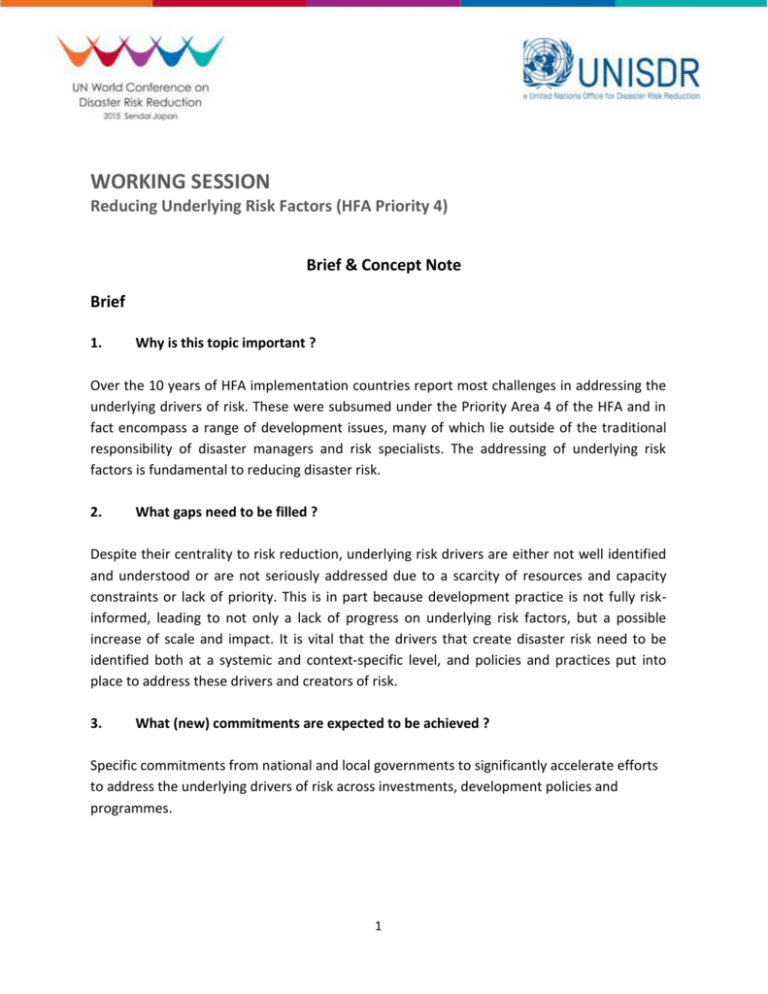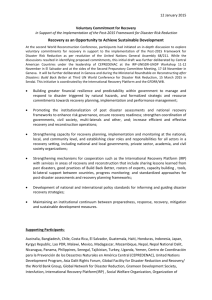Reducing Underlying Risk Factors - Third UN World Conference on
advertisement

WORKING SESSION Reducing Underlying Risk Factors (HFA Priority 4) Brief & Concept Note Brief 1. Why is this topic important ? Over the 10 years of HFA implementation countries report most challenges in addressing the underlying drivers of risk. These were subsumed under the Priority Area 4 of the HFA and in fact encompass a range of development issues, many of which lie outside of the traditional responsibility of disaster managers and risk specialists. The addressing of underlying risk factors is fundamental to reducing disaster risk. 2. What gaps need to be filled ? Despite their centrality to risk reduction, underlying risk drivers are either not well identified and understood or are not seriously addressed due to a scarcity of resources and capacity constraints or lack of priority. This is in part because development practice is not fully riskinformed, leading to not only a lack of progress on underlying risk factors, but a possible increase of scale and impact. It is vital that the drivers that create disaster risk need to be identified both at a systemic and context-specific level, and policies and practices put into place to address these drivers and creators of risk. 3. What (new) commitments are expected to be achieved ? Specific commitments from national and local governments to significantly accelerate efforts to address the underlying drivers of risk across investments, development policies and programmes. 1 Concept Note Schedule Monday 16 March 2014, 10:00-11:30 Room and Venue Hagi Hall, Sendai International Conference Centre Organizing Team Global Network of Civil Society Organisations for Disaster Reduction (GNDR), International Consortium on Landslides (ICL), Ministry of Land, Infrastructure and Transport (MLIT, Government of Japan), Japan Water Agency, PSAG representative, UNESCO, UNDP, UNU, WMO, UNISDR UNISDR Focal Points Bina Desai (desaib@un.org); Rhea Katsanakis (katsanakis@un.org) Background and Rationale Over the period of the HFA (2005-2015) to date, countries have consistently reported challenges in addressing the underlying factors and drivers of risk. A combination of limited political commitment and stringent institutional arrangements often constitute the main barrier to success in this area. As a result, disaster impacts and economic losses in particular have steadily grown over the last decades and are set to increase in the future. A post-2015 framework for disaster risk reduction and much of the analysis that has come before is calling for a considerable shift of attention at a country level, towards risk-informed development beyond the defined responsibilities of disaster management agencies. The Working Session will provide an opportunity present and discuss concrete country and locality examples that clearly unpack different underlying drivers of risk and also show ways that these have been or will be addressed. During the period of the HFA countries have made significant investments to reduce risks through different sectors, including health, education and the environment. In addition, a growing number of innovative approaches in these sectors have risk reduction co-benefits. Examples of investments in (or effectively financing for) both structural and non-structural measures will be discussed, presenting adaptable combinations of possible measures suitable for specific settings. Governments, private sector, civil society and international actors need to adapt appropriate combinations of measures to country and local contexts to ensure that development in general is fully informed by disaster risk. Session Objectives The Working Session will allow panellists to identify concrete underlying risk factors and ways to manage them 2 Government and organisations’ representatives will commit to practical steps to address drivers of vulnerability and exposure in their country contexts and present proposals to measuring progress against underlying risk drivers and towards sustainable development post-2015 They will present new combinations of risk-sensitive development measures, including structural and non-structural disaster risk management strategies, that equally address underlying drivers such as inequality and lack of accountability as well as badly managed urban development, environmental change and economic growth. Concrete examples of how underlying risk can be addressed by ensuring that sustainable development is fully risk-informed and people-centered. Discussion agenda and structure 1. Introduction and welcoming remarks (5minutes) by chair and moderator 2. Short interventions on identifying and managing risk drivers from 4 countries/cities, (5 minutes each = 25 minutes). 3. Open discussion in plenary with prepared contributions and commentary from the floor by representatives from major groups (40 minutes) focused on the themes of commitments to be made in the session. 4. Declaration of commitments from the panel and the floor (15 minutes) 5. Closing remarks by chair and moderator (5 minutes) Expected outcomes and commitments /special announcements in support of a post2015 framework for DRR Overall recommendations for post-2015 tied to concrete country commitments: to develop specific strategies, for example on risk knowledge, governance and accountability, that contribute to making all national development planning risk-informed. to establish actionable national and local mechanisms in which civil society can be “bridge builders” where governance failures drive disaster risk. Expected number of participants 500 Background documents - 3







